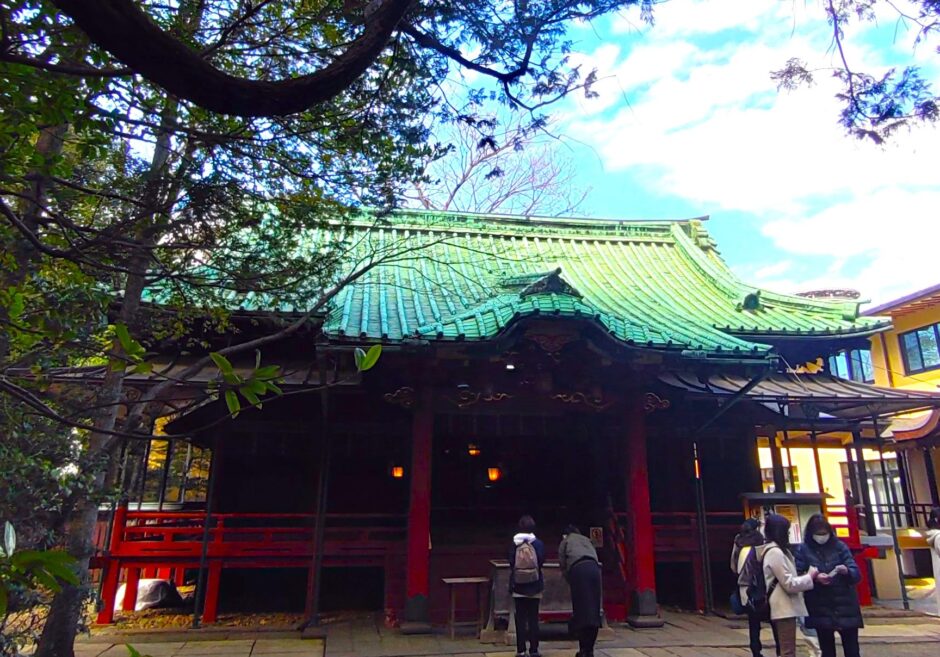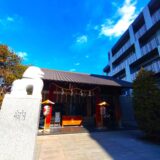【summary】
In 951, while on a pilgrimage in the eastern part of Japan, the priest Renrin spent the night in Ittsugi Village (near today’s Akasaka 4-chome), where he received an oracle from the deity and built a shrine to worship him. In the summer of 1066, about 100 years later, there was a drought in the Kanto area, and the villagers prayed to the shrine for rain. Since then, the shrine has been deeply worshipped by the Edo shogunate. In the first year of Meiji (1868), the shrine was designated by Emperor Meiji as an “associate imperial shrine” to pray for the protection of the new capital, Tokyo, and the peace of all people. The shrine survived the Great Ansei Earthquake, the Great Kanto Earthquake, and the Tokyo Air Raid, and has remained as it was when it was first built.
![Akasaka Hikawa Shrine [Tokyo] DSC 0867 1024x768 - Akasaka Hikawa Shrine [Tokyo]](https://japan-shrine.info/wp-content/uploads/DSC_0867-1024x768.jpg)
The main deities are Susanono-no-mikoto, Kushinadahime-no-mikoto and Oonamujimikoto. The name “Hyogawa” is said to come from the Hyogawa River in Izumo Province (present Hii River in Shimane Prefecture), and the upper reaches of the Hyogawa River are said to be the stage of the “eight-forked serpent extermination” by Susanowo-no-mikoto, the god of the shrine.
【premises】
Although it is located in the big city of Akasaka, once you pass through the torii gate, you will find a lot of greenery, and it feels like a quiet, different space.
![Akasaka Hikawa Shrine [Tokyo] DSC 0864 1024x768 - Akasaka Hikawa Shrine [Tokyo]](https://japan-shrine.info/wp-content/uploads/DSC_0864-1024x768.jpg)
The area is larger than expected and there are many places of interest, so it is a good idea to take a leisurely stroll.
![Akasaka Hikawa Shrine [Tokyo] DSC 0852 1024x768 - Akasaka Hikawa Shrine [Tokyo]](https://japan-shrine.info/wp-content/uploads/DSC_0852-1024x768.jpg)
The shrine has long been known as a shrine for good marriages and I had the impression that there were many female worshippers. It is said to be beneficial for the fulfillment of difficult love.
![Akasaka Hikawa Shrine [Tokyo] DSC 0851 1024x768 - Akasaka Hikawa Shrine [Tokyo]](https://japan-shrine.info/wp-content/uploads/DSC_0851-1024x768.jpg)
Miraculously, the shrine has been preserved in its original form, and was designated as a Tangible Cultural Property (architectural structure) by the Tokyo Metropolitan Government in 1976. It is a rare building that has remained intact since the Edo period, although it has been reinforced. The building survived the Great Kanto Earthquake and the Tokyo Air Raid, and is believed to be effective in warding off bad luck.
![Akasaka Hikawa Shrine [Tokyo] DSC 0853 1024x670 - Akasaka Hikawa Shrine [Tokyo]](https://japan-shrine.info/wp-content/uploads/DSC_0853-1024x670.jpg)
The floats and portable shrines that parade in the Akasaka Hikawa Festival, held annually around 9/15 to 9/18, are on display, and the Hikawa Festival is a must-see.
![Akasaka Hikawa Shrine [Tokyo] DSC 0858 1024x724 - Akasaka Hikawa Shrine [Tokyo]](https://japan-shrine.info/wp-content/uploads/DSC_0858-1024x724.jpg)
It is believed to have grown here before the shrine was relocated, and has been a symbol of Akasaka Hikawa Shrine since the early Edo period. It is a natural monument of Minato City.
【scenery】
![Akasaka Hikawa Shrine [Tokyo] DSC 0871 1024x768 - Akasaka Hikawa Shrine [Tokyo]](https://japan-shrine.info/wp-content/uploads/DSC_0871-1024x768.jpg)
The shrine is so green and quiet that it is hard to believe it is in the heart of the city, and there is a drum bridge near the entrance from the Hikawa-zaka direction.
![Akasaka Hikawa Shrine [Tokyo] DSC 0875 1024x768 - Akasaka Hikawa Shrine [Tokyo]](https://japan-shrine.info/wp-content/uploads/DSC_0875-1024x768.jpg)
The pond is now dead, but the scenery is still in harmony with the bridge.
![Akasaka Hikawa Shrine [Tokyo] DSC 0870 1024x768 - Akasaka Hikawa Shrine [Tokyo]](https://japan-shrine.info/wp-content/uploads/DSC_0870-1024x768.jpg)
Shiawase Inari is located across the Taiko Bridge. The name “Shiawase Inari” was coined by Katsunobu Katsu, who enshrined the nearby Furonare Inari, Jito Inari, Hon Hikawa Inari, and Tamagawa Inari, combining the words “four shrines enshrined together,” “happiness,” and “joining of aspirations.
![Akasaka Hikawa Shrine [Tokyo] DSC 0880 1024x768 - Akasaka Hikawa Shrine [Tokyo]](https://japan-shrine.info/wp-content/uploads/DSC_0880-1024x768.jpg)
There are about three entrances to Akasaka Hikawa Shrine, but the approach from Hikawa-zaka is thought to be the oldest, and you can feel the history everywhere. The Taiko Bridge and other parts of the shrine are tasteful, and I recommend visiting from this side.
【Nearby attractions】
Hie Shrine, National Diet Building, Tokyo Tower, etc.
【Access】
Manager’s Comments
It was cut off from the hustle and bustle of the city center, and the atmosphere was as if time had stopped. The shrine has a long history as an important cultural asset and natural monument, and I think it is also rich in various expressions from season to season. Perhaps it was because the shrine was covered with greenery, but I enjoyed the quiet atmosphere of the shrine as if the sunlight was escaping. I would like to visit the shrine again.
 Tour of Japanese shrines and temples
Tour of Japanese shrines and temples 

![Akasaka Hikawa Shrine [Tokyo] DSC 0891 520x300 - Akasaka Hikawa Shrine [Tokyo]](https://japan-shrine.info/wp-content/uploads/DSC_0891-520x300.jpg)
![Akasaka Hikawa Shrine [Tokyo] DSC 0494 Object Removal 150x150 - Akasaka Hikawa Shrine [Tokyo]](https://japan-shrine.info/wp-content/uploads/DSC_0494_Object-Removal-150x150.jpg)
![Akasaka Hikawa Shrine [Tokyo] DSC 0545 150x150 - Akasaka Hikawa Shrine [Tokyo]](https://japan-shrine.info/wp-content/uploads/DSC_0545-150x150.jpg)
![Akasaka Hikawa Shrine [Tokyo] DSC 0531 150x150 - Akasaka Hikawa Shrine [Tokyo]](https://japan-shrine.info/wp-content/uploads/DSC_0531-150x150.jpg)
![Akasaka Hikawa Shrine [Tokyo] DSC 0592 150x150 - Akasaka Hikawa Shrine [Tokyo]](https://japan-shrine.info/wp-content/uploads/DSC_0592-150x150.jpg)

